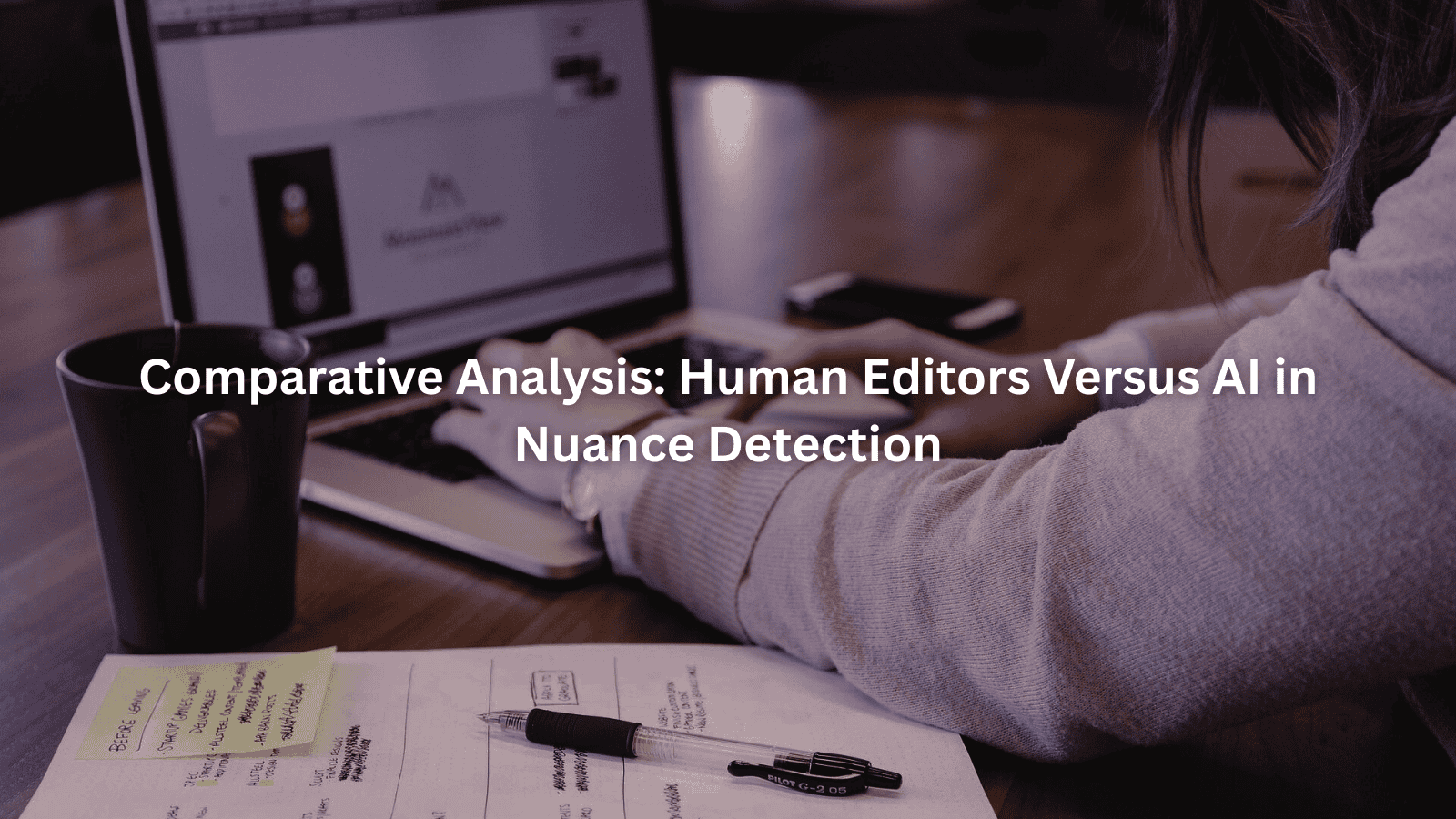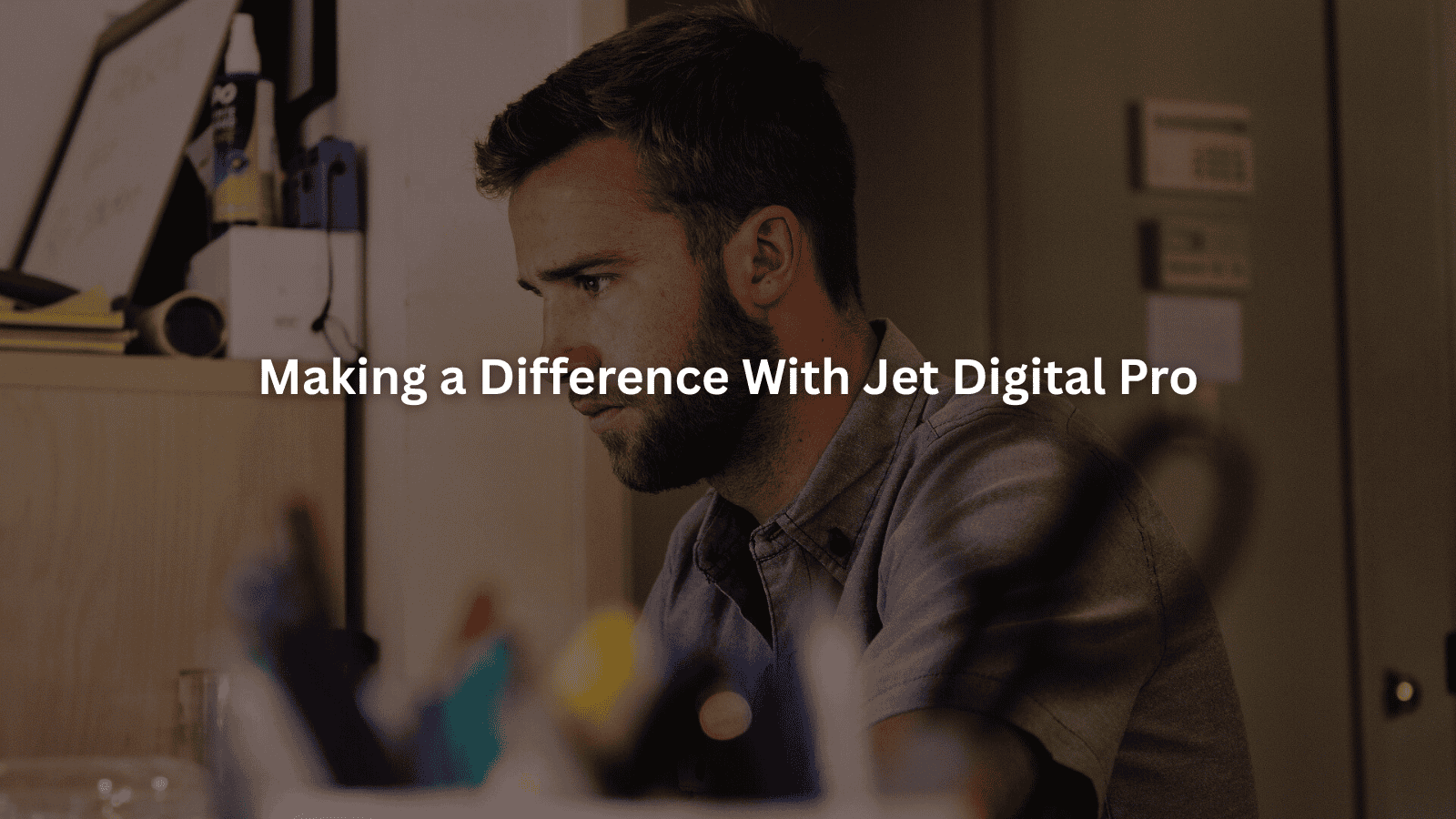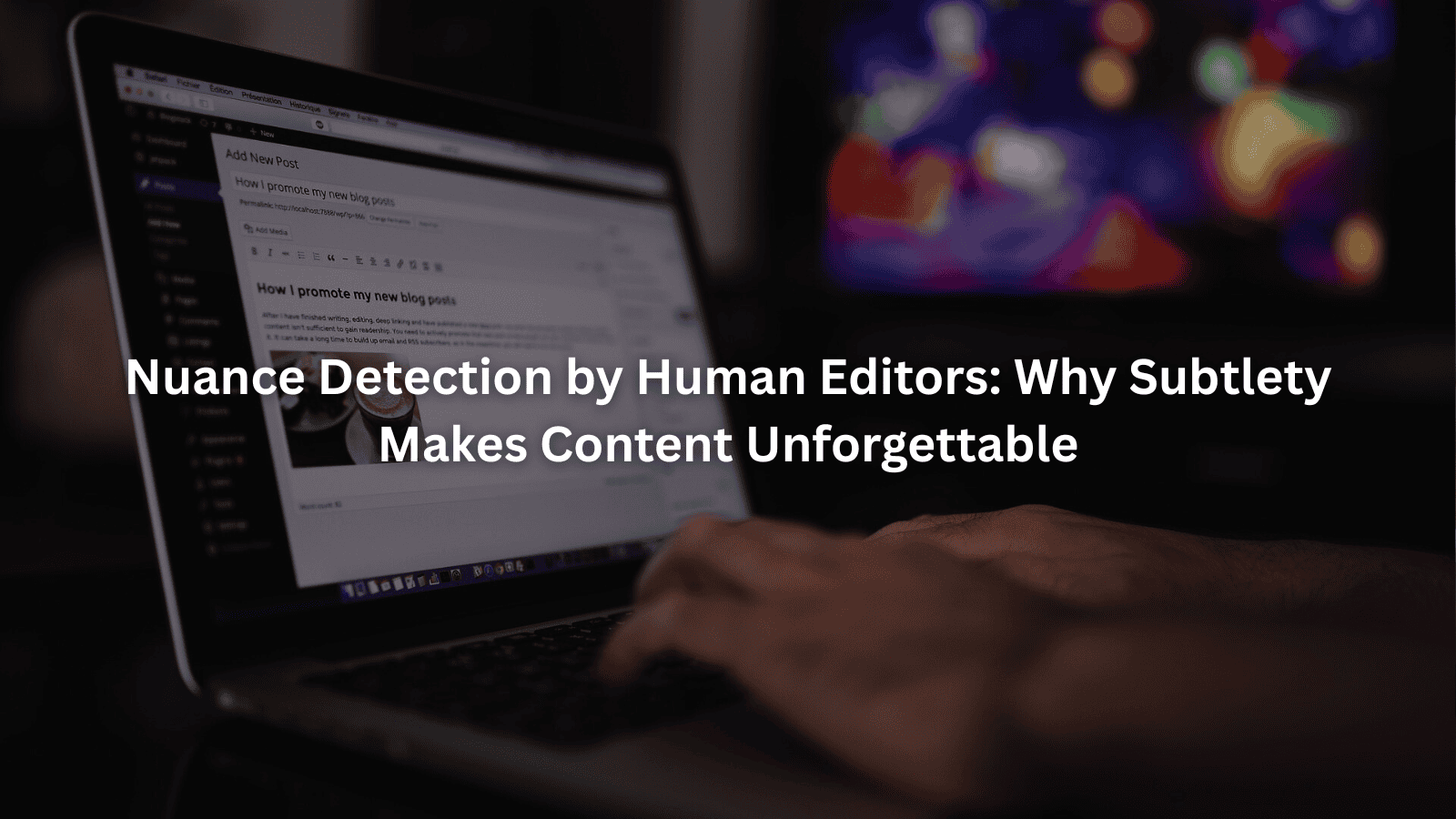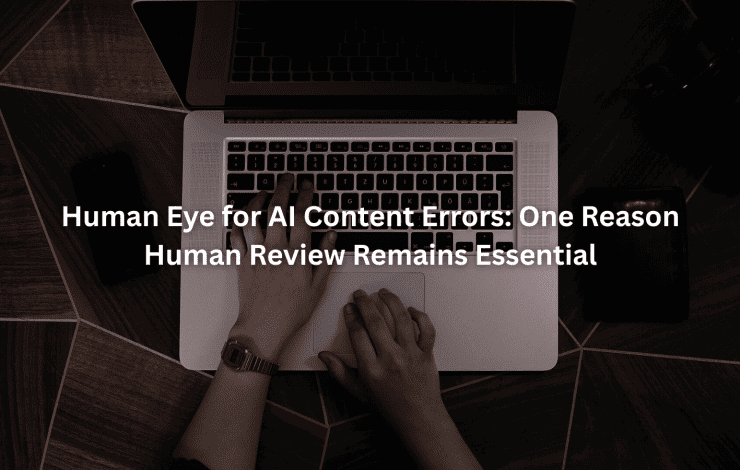Use of nuance shapes every line we edit. We believe that what’s unsaid in a sentence is often as crucial as what’s written. A well-placed word or a shift in tone can change an entire argument. That’s where human editors step in, reading not just for grammar, but for the soul of a piece.
Key Takeaways
- Human editors read for context, emotion, and intent, ensuring every nuance lands.
- Our experience and cultural awareness catch what algorithms overlook, subtlety, implication, and tone.
- Jet Digital Pro blends AI efficiency with human sensitivity, making content both accurate and resonant.
Nuance Detection by Human Editors: Core Concepts and Significance
Editing isn’t about marking up typos or rearranging sentences. It’s about hearing the author’s voice between the lines and feeling the weight of every phrase. From our years in the field, we know nuance means more than subtlety. It’s about connotation, denotation, and the difference between saying and meaning.
Defining Nuance Detection
Nuance detection is the editor’s art of recognizing meaning that goes beyond the obvious. We find layers, undertones, double meanings, and emotional shading, hidden within plain language. This often shows up when a writer lets a metaphor dangle, or slips a hint of irony into a description. Even in technical writing, a word’s connotation can lead a reader in an unexpected direction.
Recognizing Subtle Meaning Layers
We’ve seen how a single word can shift a paragraph’s intent. Once, working on a client’s blog, the phrase “cautiously optimistic” replaced “hopeful.” That change gave the piece more credibility, hinting at skepticism. This is nuance: the gradation of meaning, the sly wink of an idiom, the implication that’s never directly stated.
Differentiating Tone, Style, and Emotion
It’s not enough to know what a word means. We look for tone, sarcasm, warmth, skepticism. We listen for style. One essay might need the dry detachment of a scientific paper, another the emotional resonance of a memoir. Each genre, each author, carries their own undertone. We tune into that.
Importance of Nuance Detection
Ensuring Accurate Communication
Without nuance, words become blunt instruments. We’ve seen drafts where an author’s intent was lost because the subtext was ignored. For instance, a joke meant as gentle teasing might read as harsh criticism without a touch of editing. Nuance preserves intention.
Preserving Cultural and Contextual Relevance
A phrase can mean one thing in New York, another in Jakarta. Editors catch references, idioms, or figures of speech that might confuse a global audience. We once changed “kick the bucket” to “passed away” for an international article, softening the tone and avoiding confusion. That’s nuance in practice.
As discussed in Modern Diplomacy, ethical editing in the age of AI demands a deep awareness of context, not just compliance with linguistic norms. The goal isn’t correctness alone, but resonance and understanding of how a phrase lands across borders and cultures. [ 1 ]
Maintaining Authorial Voice and Emotional Undertones
Writers trust us with their voices. We make sure their personality shines through. Stripping out nuance for the sake of clarity can leave writing flat. We preserve emotional undertones, regret, hope, irony, so readers feel what the writer felt.
Enhancing Reader Engagement and Depth
Readers sense when something’s missing. They skim texts that lack subtlety, but linger over lines that suggest more. Nuance invites the reader to look closer, to interpret, to care. It’s what keeps content from fading into the background.
Essential Skills and Techniques in Nuance Detection

Nuance editing isn’t something you pick up overnight. It’s honed through experience, trial and error, and sometimes, just listening hard enough. The techniques we use come from years of reading, writing, and paying attention to what moves us.
Key Abilities for Editors
Contextual Evaluation of Language Use
We always ask, “Why this word here?” Context is king. In a technical paper, “significant” means statistically important; in a poem, it might mean emotionally charged. We look at surrounding sentences, the overall argument, and even the likely audience. It’s about fitting the word to the moment.
Sensitivity to Tone Shifts and Emotional Subtext
Tone can shift mid-sentence. We’ve caught moments when a client’s press release moved from formal to oddly casual, one misplaced “Hey” in an otherwise professional note. Our job is to keep tone consistent, unless a deliberate change serves the message.
Interpretation of Figurative and Idiomatic Expressions
Idioms and metaphors can trip up even native speakers. We once edited a piece for British readers, where “throw in the towel” worked, but for an Asian audience, it fell flat. We swapped it for “call it a day,” keeping the intent. That’s nuance.
Audience Adaptation for Cultural and Sophistication Variations
Every audience brings different expectations. We adapt, simplifying an idiom for younger readers, or adding depth for a scholarly crowd. It’s not about dumbing down, but about matching style to reader sophistication and cultural habits.
Editorial Techniques
Balancing Connotation and Denotation
Every word has a literal meaning (denotation) and an emotional, cultural one (connotation). We weigh both. When editing health content, “treatment” might sound clinical, but “care” feels compassionate. We decide which suits the author’s intent.
Rewriting for Clarity, Precision, and Subtext Preservation
Sometimes, clarity and nuance pull in different directions. Our approach: rewrite for both. We’ll rephrase “He was blue” to “He was quietly sad,” if the metaphor risks confusion. Yet, we fight to keep the emotional shading.
Ensuring Narrative and Character Consistency in Fiction
Characters need consistent voices. We’ve fixed scenes where a shy character suddenly spoke with confidence, unintentionally breaking the narrative flow. Nuance means catching those slips, making dialogue and motivation believable.
Providing Layered, Constructive Feedback
We don’t just mark mistakes. We ask questions, suggest alternatives, and explain why a change matters. Our feedback often includes, “What if you tried this?” or “Does this phrase capture what you mean?” It’s a conversation, not a correction.
Comparative Analysis: Human Editors Versus AI in Nuance Detection

AI has gotten smarter. Still, there are gaps, places where only a human can read between the lines. We see this every day. If you’ve ever wondered how human editing stacks up against AI grammar tools, the differences become obvious when tone, style, and subtlety are at stake.
Strengths of Human Editors
Experience-Driven Intuition and Cultural Insight
We draw on years of reading, travel, and conversation. Algorithms can’t recall the feeling of a classroom debate or the way a joke lands differently at a family dinner. Our intuition fills in what machines can’t see.
Creative Judgment in Balancing Subtlety and Clarity
Editing is a balancing act. Too much subtlety and a message is lost. Too much clarity and it loses depth. We decide, based on the text, the audience, and the goal, where that balance should lie. Machines tend to pick one or the other.
Recognition of Originality and Tone Authenticity
We spot clichés. We notice when a phrase sounds too familiar, too much like something an AI would write. Our edits aim for genuine originality, not just a rearrangement of words.
Detecting AI-Generated Text Patterns and Nuance Deficiencies
There’s a rhythm to AI writing, a pattern of repetition, a lack of emotional shading. We’ve spent hours editing AI-generated drafts, watching for those tells. Machines miss emotional undertones, cultural jokes, or subtle bias. We don’t.
AI detection guides have noted how AI often leaves subtle footprints, like mechanical transitions or a missing sense of intention, making human review essential for high-stakes or brand-sensitive content. [ 2]
Limitations of AI Systems
Challenges in Interpreting Complex Emotional and Contextual Cues
AI gets lost in ambiguity. We’ve seen it flatten irony into literal statements, or miss the point of a metaphor. It struggles with intonation, implication, or emotional resonance, especially in creative work.
Tendency toward Formulaic or Overly Literal Output
AI likes formulas. It repeats structures, follows templates, and sometimes, drains the life from a text. Human editors restore that life, adding back the nuance, the surprise, the voice.
Practical Applications of Nuance Detection
Nuance isn’t just for poetry. We use it in every genre, every field, and every project.
Scientific and Technical Manuscripts
Calibrating Speculation and Certainty in Language
Are You a Digital Agency?
White Label SEO Content Services for Agencies
Scalable, customizable, and results-driven content solutions for your clients.
Science demands precision. We’ve edited research papers where a single word, “may” versus “does”, changed the credibility of a finding. Overstating results risks an editor’s reputation and the author’s. We calibrate language, keeping speculation honest and certainty grounded.
Translation and Localization
Capturing Emotional Resonance and Cultural Nuance
Translating isn’t just swapping words. It’s about carrying emotional resonance and cultural references across borders. We once localized a marketing campaign, changing “home run” (nonsensical in cricket-loving countries) to “hit it out of the park” or “scored a goal.” Nuance makes translation work. Capturing emotional resonance and cultural nuance.
Creative Writing and Narrative Development
Refining Voice, Themes, and Character Motivations
Writers pour themselves into characters and themes. We help clarify motivation, deepen theme layering, and sharpen voice. Sometimes, it’s a matter of asking like “Does this line echo your theme?” Our edits bring fiction closer to life.
- Clarifies character intentions and motivations.
- Deepens thematic layers within the narrative.
- Questions like, “Would this character really say that?” can elevate the story.
Editing AI-Generated Content
Identifying and Correcting Lack of Depth and Original Insight
AI-generated content often lacks depth. We fix that. We look for places where ideas feel thin, where sentences sound hollow, and where original insight is missing. Our edits bring back complexity and subtlety, qualities machines can’t fake.
At Jet Digital Pro, we blend of human skill and AI grammar tools ensures that grammar isn’t just technically correct, it supports meaning, tone, and flow.
Making a Difference With Jet Digital Pro

At Jet Digital Pro, we don’t just rely on technology. We believe in the irreplaceable value of human editors. Our mix of AI-driven efficiency and human editorial insight means every piece gets both the speed of automation and the sensitivity of a practiced eye.
We know nuance because we live with it. Our editors bring their own backgrounds, biases, and experiences to every sentence they shape. We’ve worked with agencies needing content that will pass both Google’s eyes and a reader’s heart. That means checking not just for error, but for meaning, implication, and resonance. That’s why we rely on human proofreading that elevates AI writing, restoring nuance and refining intention in ways automation still can’t match.
Our white-label SEO solutions are built on a simple promise: AI speed, human depth. That way, your content isn’t just optimized, it resonates and passes human sniff tests. Our services scale with your needs, but our attention to nuance stays personal.
If you want writing that connects, persuades, and endures, you need editors who understand nuance. That’s what we do, every day, for every client. And we think it shows.
FAQ
How do human editors handle cultural references that might confuse an international audience?
Need a Strategic SEO Content Partner?
Let’s craft SEO content that ranks, converts, and grows your brand.
Talk to UsOften, what seems normal to one group can puzzle or even offend another. Human editors look for these cultural references and ask, “Will everyone understand this?” If not, we either explain it, substitute a more universal phrase, or add a note. We’ve found this careful attention helps maintain clarity and keeps the writing relatable for a wider audience.
What steps do editors take to spot subtle bias or unintended undertones?
Subtle bias can sneak in through word choice or even sentence structure. Human editors read with a skeptical eye, asking how each phrase might sound to someone outside the writer’s circle. We compare sentences, check for loaded language, and sometimes consult with colleagues. This extra effort helps us catch messages the writer didn’t mean to send, keeping the content fair and balanced.
In what ways do editors ensure consistency in tone when several writers work on the same project?
When several writers contribute, the tone can shift without anyone realizing it. Human editors read larger sections together, making notes on shifts in vocabulary, formality, or attitude. We then suggest edits to smooth out these differences, so the finished piece feels like it has one clear, steady voice. This process keeps the project coherent and easier for readers to follow.
How do editors decide when to keep or change idioms and figurative language?
Idioms and figurative language can add color, but they sometimes confuse readers who aren’t familiar with them. We weigh the impact, does the phrase make the writing stronger, or does it risk misunderstanding? If it’s likely to confuse, we suggest a clearer alternative or add context. If it adds just the right touch, we leave it in. It’s a judgment call every time.
What do human editors do when they spot ambiguous sentences that could be read in more than one way?
When a sentence could mean two things, editors don’t just guess. We ask the writer for clarification, look at surrounding paragraphs, and consider the likely intent based on context. If the ambiguity doesn’t serve a purpose, we suggest a rewrite. Our goal is to make sure the intended meaning comes through, so readers aren’t left puzzled or misled.
Conclusion
Nuance isn’t accidental, it’s the result of editors who understand both meaning and precision. At Jet Digital Pro, we’ve seen how AI can help, but only human judgment can deliver content that truly connects. That’s why our 11-step editing process goes beyond surface-level fixes to refine every word for clarity, tone, and impact. When your agency needs scalable, SEO-smart content that feels human, we’re the partner who gets it right.
Let’s talk. Contact us here.
References
- https://moderndiplomacy.eu/2025/06/04/ethics-in-the-age-of-ai-why-context-matters-more-than-compliance/
- https://learn.g2.com/was-this-written-by-ai
Related Articles
- https://jetdigitalpro.com/human-ai-editor-for-proofreading-grammar/
- https://jetdigitalpro.com/human-editor-vs-ai-grammar-tool/
- https://jetdigitalpro.com/human-proofreading-ai-generated-text/
P.S – Whenever you’re ready,
we’re here to help elevate your SEO content.
Partner with us for strategic, scalable content that drives real organic growth.
Contact Us Now




